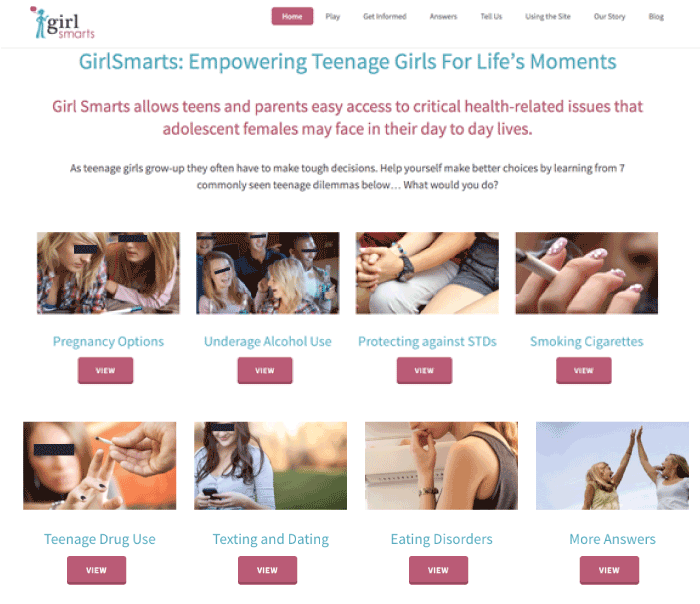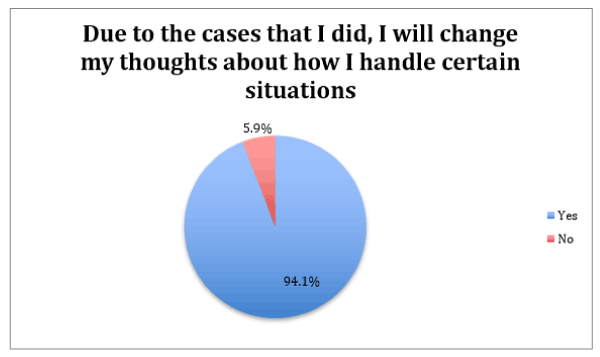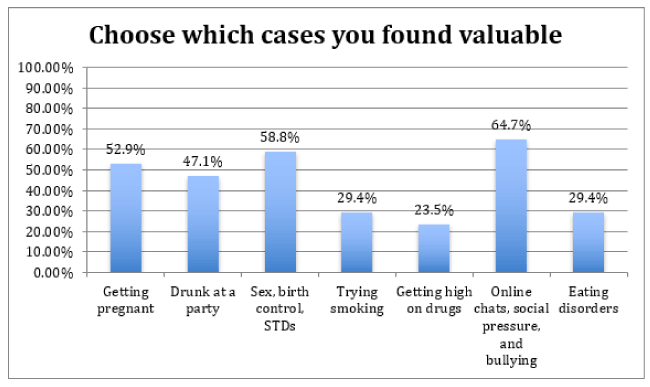The Girlsmarts website (www.girlsmarts.org) was built to allow teens to virtually experience the consequences of high-risk behaviors prior to experiencing them in life. As the prefrontal cortex of the brain, involved in understanding the repercussions of decisions, continues to develop throughout the teenage years, allowing teens to understand consequences can promote better decision making. The Girlsmarts website houses 7 cases which address common situations teens face, but no measureable data regarding website value had ever been obtained. The aim of this project was to determine who accesses the website Girlsmarts and to assess the value that it brings to it’s viewership.
To explore these questions, the website encouraged individuals to complete a voluntary and anonymous survey that obtained information regarding effectiveness of content and also user demographics. Analysis of 45 surveys revealed the website was viewed by teenage girls 51% of the time, while it was viewed by a teachers/educators 20% of the time. 96% of viewers reported that the cases did impact how they would handle certain situations.
Based on these findings, adolescent females and their educators do benefit from viewing the Girlsmarts website. This web-based learning can equip adolescents with the tools to better react to certain risky situations. It may also allow educators to supplement their existing curriculum in order to better educate adolescents about difficult and risky situations.
adolescent, girls, girlsmarts, judgment, risk-taking, teen pregnancy
The teenage years revolve around the quest to develop an individual moral code and identity. As children enter the teenage years, they tend to shift communication away from their parents and towards their social environment. During this process, self-regulation, or the ability to exert control over one’s actions, can be difficult for adolescents [1]. This period of discovery and difficulty with self-control is postulated to be due to the delayed maturation of the prefrontal cortex [2,3].
The prefrontal cortex plays an essential role in higher-order cognitive processes and executive functioning. These skills are responsible for the ability to plan, maintain inhibitions, and practice goal-directed behavior [3]. Without these traits, teens can choose to make decisions that lead to “instant gratification.” Many of these decisions may result in high-risk situations. While some high-risk behaviors, such as the use of illicit drugs, has improved from 23% to 14% over the last 10 years, other high risk behaviors have emerged. As an example, studies note decrease use of condoms, with only 54% of high school students now using condoms, a statistic that has decreased 8% from 2007 through 2017 [4].
Knowledge of consequences prior to encountering a high-risk behavior may alter a teen's reaction to a situation, and allow them to respond more favorably. Using simulation as an education tool could help teens analyze a high-risk behavior prior to experiencing the situation first hand. Seeing how others handle the high–risk situation would help build refusal skills and knowledge of the hardships associated with these behaviors, and may motivate teens to avoid potentially detrimental activities.
A literature review reveals that there has been little research exploring the use of digital health tools in teen education and prevention of high-risk behaviors. This form of education is in need of more careful attention, as approximately 84% of teens have used online health information [5]. This high rate of use among teens underscores the need for accurate and teen friendly web-based information.
To close this gap, the website www.girlsmarts.org was created with the goal of creating new avenues to educate and promote healthy choices among adolescents. Currently, the website hosts 7 scenarios of “risky behaviors” for viewing. Topics addressed include, but are not limited to Consequences of Unprotected Intercourse (pregnancy and sexually transmitted infections), Consequences of Underage Alcohol, Drug or Tobacco Abuse, Internet Dangers, and/or Eating Disorders (Figure 1). Prior to the creation of each case, teen focus groups were utilized to ensure relevance to the average teen. For each situation, there is a summary of pertinent health facts. These health facts serve to provide further education for the participants. There are also additional web links where teens can access other healthcare resources. After viewing the cases, individuals have the opportunity to complete a survey regarding the website.

Figure 1. List of Cases that Teens Can Access at www.girlsmarts.org
In this preliminary study, we aim to use the Girlsmarts website’s survey to collect information on our user demographics and determine overall effectiveness of the site. This project sought to validate the perceived utility of online module education provided by GirlSmarts.
Participants
After viewing the cases and exploring other resources on the website, the site encouraged all participants to complete a survey (Figure 2). Any individual who visited the site had the opportunity to submit a survey, regardless of how many modules they completed. Participation was completely anonymous and the participants were required to consent to allow the information gathered to be used for research purposes.

Figure 2. Survey taken by participants viewing the Girlsmarts website
Survey
This survey was brief, with only seven questions, in an effort to promote efficiency and thus attract more respondents. There was no way to link the survey results to any individual participant. At the end of the survey, participants were able to check a box to allow the survey information to be used anonymously for research purposes. Once this box had been checked, the survey answers were forwarded electronically to the primary investigator for review. The survey items included participant’s demographics, their feelings regarding how the information would change their handling of high-risk situations, which cases they found valuable, how they found out about the GirlSmarts website, and the people with whom they would likely share this information. The survey also asked for suggestions on additional topics participants would like to see addressed on the website in the future.
Analysis
After approval from the University of Oklahoma Institutional Review Board, 45 surveys were collected from April 2016 to April 2017. Responses were compiled and analyzed to assess demographics of those viewing the website and perceptions of educational value of the cases. All the information was compiled into a data pool and descriptive statistical techniques were performed using Microsoft Excel.
At the conclusion of our study, 45 surveys were collected. The majority of GirlSmart users identified themselves as teenage girls (51%). The remaining users reported themselves to be Teachers/Educators (20%), Parent/Guardian (11%) or “Other” (18%).
Participants were from all parts of the United States as noted in Table 1, and 7% were noted to be viewing the site from outside the United States of America. Most learned about the website from friends (49%). Others learned of the site from their school (29%) or Google (27%) (Table 1).
Table 1. Results of Survey taken after participants viewed Girlsmarts website
Which best describes you? |
Description |
n |
Percentage |
Teenage girl |
23 |
51.1% |
Parent or Guardian |
5 |
11.1% |
Teacher or Educator |
9 |
20% |
Teenage boy |
0 |
0% |
Other |
8 |
17.8% |
|
|
|
Where do you live? |
Northeastern USA |
14 |
31.1% |
Southern USA |
16 |
35.6% |
Midwestern USA |
10 |
22.2% |
Western USA |
2 |
4.4% |
Other USA |
0 |
0% |
Outside USA |
3 |
6.7% |
|
|
|
Due to the cases that I did, I will change my thoughts about how I handle a certain situation |
Yes |
43 |
95.6% |
No |
2 |
4.4% |
|
|
|
Choose which cases you found valuable |
Getting pregnant |
31 |
68.9% |
Drunk at a party |
24 |
53.3% |
Sex, birth control, STDs |
32 |
71.1% |
Trying smoking |
17 |
37.8% |
Getting high on drugs |
12 |
26.7% |
Online chats/pressures, rape, & bullying |
28 |
62.2% |
Eating disorders |
19 |
42.2% |
|
|
|
How did you find out about GirlSmarts.org? |
Google |
12 |
26.7% |
Yahoo |
2 |
4.4% |
Bing |
0 |
0% |
Friend |
22 |
48.9% |
Facebook |
3 |
6.7% |
Twitter |
0 |
0% |
School |
13 |
28.9% |
Other online |
3 |
6.7% |
News |
0 |
0% |
|
|
|
Who would you discuss what you learned on GirlSmarts.org with? |
Friends |
31 |
68.9% |
Parents |
16 |
35.6% |
Teachers |
14 |
31.1% |
I would not discuss |
11 |
24.4% |
96% of website users felt the online cases changed their thoughts about how they would handle certain high-risk situations (Figure 3).

Figure 3. Participant perception on changes in their handling of situation after viewing the Girlsmarts website
Data also evaluated cases that viewers of the website found most valuable. Viewers felt that cases on the topics of Sex, birth control and STDs were most valuable (71%). Cases on the topics of Getting Pregnant and Online Chatting, Date rape and Bullying were also very highly regarded as valuable (69% and 62%, respectively) (Figure 4).

Figure 4. Participants perception of value of various cases within the Girlsmarts website
When asked with whom they might discuss the information learned from Girlsmarts, 69% said friends, while only 31-36% said a parent/guardian or teacher (Table 1). New cases that were most often requested in the written portion of the survey included cases on the topics of teen suicide, bullying and depression/anxiety.
Adolescent females and their educators/guardians can benefit from use of the Girlsmarts (www.girlsmarts.org) website. The majority of viewers felt the site was effective as it allowed viewers to see the consequences of high-risk behaviors. Because of the delayed maturation of the prefrontal cortex in teens, teens are often unable to conceptualize the consequences that result from certain behaviors. This is especially dangerous when teens encounter high-risk decisions, such as having unprotected sex or drinking and driving. The site allows teenage viewers to imagine difficult and risky scenarios in a more educated manner, hopefully leading to better real life outcomes when such situations are encountered.
Furthermore, this site provides a valuable educational resource to teachers, educators, and parents. Teens are acquiring more information from Internet sources than ever before (5). Because of this shift in how teens are acquiring their information, it has become increasingly important to provide useful and accurate information in a form that teens will utilize. The information available on the Girlsmarts website allows the spread of information to adolescent girls that will help them make prudent, well-informed decisions when faced with difficult real life situations.
There are limitations when considering the results of this study. One limitation is the small sample size available for analysis. Only 45 surveys were collected for analysis, so the general applications of these findings are limited. There also may be a non-response bias, in that those that did not find this website useful may have been less likely to complete a survey.
There is minimal research exploring the use of online modules to enhance adolescent education regarding health and high-risk behaviors. This preliminary study sets the groundwork to follow up with further studies. Future studies could create focus groups of teens and use surveys to assess the short-term efficacy of the online information.
In conclusion, the GirlSmarts website is a beneficial resource that can potentially aid adolescent girls in making healthier decisions in difficult situations. This website, which was found useful by its participants, may be used as a supplement to other educational programs or as a stand-alone source of information. Based on these positive findings, efforts to foster future collaborations should be encouraged. With more widespread use and expansion of this resource, there is great potential to see a decline in high-risk behaviors amongst adolescent girls.
N Desilva (ND) was involved with the creation of the Girlsmarts website. She then worked closely with K Thill (KT) to obtain IRB approval for this study. KT did a large portion of the data analysis with ND’s assistance. ND and KT worked together in the creation of this manuscript.
Thank you to Heather McIntosh and Krista Kezbers for their assistance with statistical analysis and manuscript delineation.
This study did not obtain or utilize funding from any sources.
While this research received no specific funding from any agency, it is with great appreciation that we acknowledge that the Girlsmarts website was created by Giantsky Web Designers with the guidance of Dr. Nirupama DeSilva. Funding sources for the website included unrestricted grants from the American College of Obstetricians and Gynecologists and also the George Kaiser Family Foundation.
Nirupama DeSilva MD does disclose conflicts of interest, but none that relate to the topic of this is manuscript. She is an educator for Merck and also is an author for Up To Date.
Kathleen Thill MD has no conflicts of interest.
- Farley J, Kim-Spoon J (2014) The development of adolescent self-regulation: Reviewing the role of parent, peer, friend, and romantic relationships. J Adolesc 37: 433-440. [Crossref]
- Luciana M (2013) Adolescent brain development in normality and psychopathology. Dev Psychopathol 25: 1325-1345. [Crossref]
- Johnson SB, Blum RW, Giedd JN (2009) Adolescent maturity and the brain: The promise and pitfalls of neuroscience research in adolescent health policy. J Adolesc Health 45: 216-221. [Crossref]
- YRBS Data and Trends Report (2017). Retrieved from https://www.cdc.gov/features/yrbs/index.html, last accessed 6/24/19.
- Northwestern University (2015). Teens, health, and technology: A national survey. Retrieved from https://cmhd.northwestern.edu/wp-content/uploads/2015/05/1886_1_SOC_ConfReport_TeensHealthTech_051115.pdf, last accessed 6/24/19




